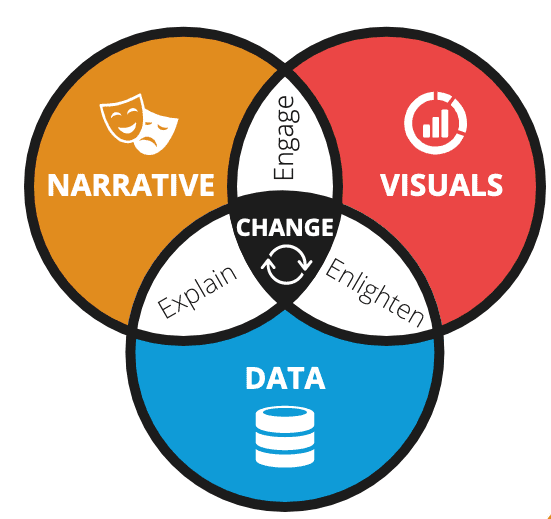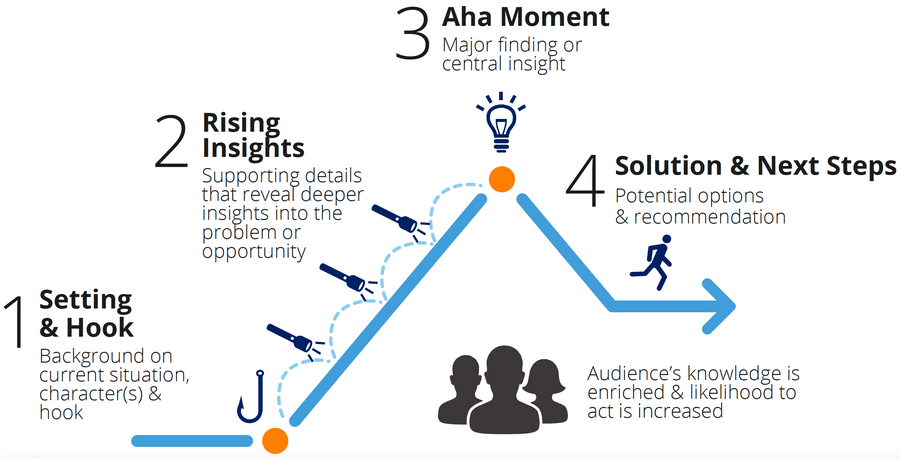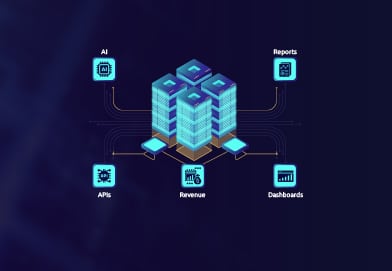Introduction
In the era of data-driven decision-making, businesses are constantly inundated with an overwhelming amount of information. While data holds immense potential, its actual value lies in the ability to transform it into actionable insights. This is where data storytelling comes into play. Data storytelling conveys complex data in a compelling narrative format, enabling organizations to make informed decisions, drive innovation, and ultimately achieve tangible business impact. In this blog post, we will explore the concept of data storytelling, its importance, and how businesses can harness its power to unlock their full potential.
What is data storytelling?
Data storytelling is an interdisciplinary approach that combines the analytical power of data analysis with the art of storytelling. It involves transforming raw data into a cohesive narrative that resonates with the intended audience. This approach enables organizations to effectively communicate insights, engage stakeholders, and drive meaningful action.
One of the primary advantages of data storytelling is its ability to extract valuable insights from complex data sets. A data storyteller can scrutinize and make sense of data to pinpoint patterns, trends, and relationships, thereby aiding in decision-making processes that drive business growth..

When presented as a story, data becomes more relatable and accessible to a broader range of individuals. Audiences are naturally more receptive to stories because they can personally understand and connect with the information. While statistics provide news, stories have a distinct advantage in creating a lasting impact. A good data story can bridge the gap between technical data and human experiences, making the insights more relevant and meaningful to the audience.
In business, data storytelling plays a crucial role in conveying the significance of data-driven insights. By weaving a compelling narrative around the data, organizations can effectively communicate their message, generate buy-in from stakeholders, and inspire action. Data storytelling is not just about presenting numbers; crafting a narrative engages the audience, creates a sense of urgency, and motivates them to take action.
The Importance of Data Storytelling
Data storytelling holds immense importance in the business world, and here are three key reasons why:
1. Engaging Stakeholders: One of the primary benefits of data storytelling is its ability to engage stakeholders effectively. Data storytelling humanizes the data and creates an emotional connection by presenting information in an easy-to-understand and relatable format. This connection captures the attention of decision-makers and stakeholders, increasing their buy-in and support for data-driven initiatives. When presented in a compelling narrative, data resonates with individuals personally, making them more likely to embrace and act upon the insights shared.

2. Enhancing Decision-Making: Raw data can be overwhelming and challenging to comprehend, especially for non-technical audiences. However, data storytelling addresses this challenge by presenting data in a narrative form that is accessible and understandable. By weaving the data into a story, decision-makers can grasp the key insights, identify patterns, and make informed decisions based on the evidence presented. Data storytelling helps translate complex data into meaningful information that decision-makers can easily interpret, enabling them to navigate uncertainty and make data-driven choices confidently.
3. Driving Business Outcomes: Data storytelling can inspire change within organizations. By presenting data in a persuasive and relatable manner, it can challenge existing beliefs, drive innovation, and influence behavior. A well-crafted data story can motivate teams to embrace new ideas, adopt data-driven practices, and propel the organization toward success. By leveraging the emotional impact of storytelling, data-driven insights are more likely to be embraced and acted upon, leading to tangible business outcomes such as increased efficiency, improved customer satisfaction, and higher profitability.
Data storytelling is essential for engaging stakeholders, enhancing decision-making processes, and driving meaningful business outcomes. By leveraging the power of narratives, organizations can effectively communicate the insights derived from data analysis, capture the attention and support of stakeholders, and inspire positive change within the organization. Take the first step towards compelling data storytelling by contacting Data Sleek today.
Key Elements of Effective Data Storytelling
To effectively engage the audience and convey insights, three key elements contribute to successful data storytelling:
1. Narrative: A compelling narrative forms the core of data storytelling. Craft a story that captivates the audience, evokes emotions, and effectively communicates the insights derived from the data. A well-structured narrative should include an introduction that sets the stage, a development section that coherently presents the data and analysis, and a conclusion that summarizes the key takeaways and encourages action. The narrative should be engaging, relatable, and aligned with the objectives of the storytelling initiative.

2. Visuals: Visual representations of data play a vital role in data storytelling. Choosing the right visuals is crucial for enhancing the narrative and facilitating understanding. Utilize charts, graphs, infographics, and other visual aids strategically to convey insights effectively. Visuals should be carefully designed, clear, and concise. They should complement the narrative and highlight the data’s key patterns, trends, or correlations. Well-designed visuals enhance comprehension and make the storytelling experience more engaging and memorable for the audience.
3. Data: Data serves as the foundation of data storytelling. Working with accurate, reliable, and relevant data supporting the presented narrative is essential. Thorough data analysis and interpretation are crucial for uncovering key insights and identifying the key messages that support the narrative. It is important to curate the data carefully, ensuring that it aligns with the storytelling objectives and effectively addresses the questions or problems. Present the data in an understandable and meaningful way to the audience, using appropriate metrics, comparisons, or benchmarks to enhance comprehension and facilitate decision-making.
Organizations can create impactful narratives that effectively communicate insights, engage the audience, and drive action by incorporating these key elements into data storytelling efforts. The story provides structure and emotional connection, visuals enhance comprehension and engagement, and data forms the basis for credibility and decision-making. In the subsequent sections, we will explore specific techniques and best practices for leveraging these elements in data storytelling to maximize their impact on business outcomes.
Data Storytelling Best Practices
To create compelling and impactful data stories, it is important to follow these best practices:
Clearly Define the Objective
Define a clear objective for the data story to guide the storytelling process. The objective should outline the purpose and desired outcome, such as identifying opportunities, addressing challenges, or showcasing the impact of a decision.

Understand the Audience
Tailor the data story to the audience by understanding their needs, perspectives, and level of data literacy. Consider their roles, familiarity with the subject matter, and specific interests to create a story that resonates with them personally and effectively conveys the desired message.

Contextualize the Data
Provide context to help the audience understand the significance of the data. Incorporate industry trends, market dynamics, or historical perspectives to help them connect the dots and make informed decisions based on the story presented.
Build a Compelling Narrative
Craft a narrative that captivates the audience by evoking curiosity, capturing attention, and creating an emotional connection. Incorporate storytelling techniques like conflict, resolution, vivid descriptions, anecdotes, and real-life examples to make the story relatable, engaging, and memorable.
Minimize Bias
Ensure objectivity and transparency in data storytelling. Be transparent about data sources, analysis methods, limitations, and assumptions. Present a balanced view and provide evidence to support conclusions, avoiding intentional or unintentional bias.
Structure and Flow
Structure the data story logically, guiding the audience through the narrative. Have a clear beginning that establishes the context, problem, or opportunity. The middle should coherently present data, analysis, and insights using visuals and storytelling techniques, while the end summarizes vital takeaways, highlights the business impact, and prompts action.

Visualize Data Effectively
Use data visualizations to simplify complex information and make it accessible. Choose visualizations that best represent the data and align with the narrative. Ensure clarity, conciseness, appropriate labeling, colors, and design elements that highlight key insights while maintaining a balance between simplicity and effectiveness.
Evoke an Emotional Connection
Create an emotional connection with the audience through the data story. Incorporate real-life examples, relatable anecdotes, or testimonials to humanize the data and make it relatable. You can motivate the audience to embrace the insights and take desired actions by appealing to emotions, such as empathy and urgency.

Add Credibility
Establish credibility by citing reputable sources, referencing industry benchmarks, or including expert testimonials. Highlight the data collection and analysis methodologies to demonstrate rigor and accuracy. Transparency and credibility strengthen the audience’s trust in the data story and increase its impact.
Emphasize the Business Impact
Highlight the impact of insights on driving positive changes, improvements, or opportunities for the organization. Clearly articulate how data-driven decisions or actions can align with business goals and objectives, demonstrating the value of the data story in achieving them.
Iteration and Feedback
Treat data storytelling as an iterative process. Test the story with a small audience and gather feedback to refine and improve it. Pay attention to questions and reactions to identify areas requiring clarification or emphasis. Iteration and feedback ensure a compelling and resonating data story for the intended audience.
Practice Delivery
Rehearse the data story presentation for confident and engaging delivery. Focus on pacing, tone, and body language to maintain audience engagement. Practice helps anticipate and address potential questions or objections that may arise.

Following these best practices, you can create data stories that effectively communicate insights, engage the audience, and drive informed decision-making.
Narrative Model and Data Storytelling Arc
In data storytelling, Freytag’s Pyramid provides a helpful narrative model for captivating the audience and delivering impactful insights. This structure consists of five elements:
- Setting & Hook (Exposition): Introduce the context and objective of the data story, capturing the audience’s attention.
- Rising Insights (Action): Present data, analysis, and insights using engaging storytelling techniques and visuals.
- Aha Moment (Climax): Reveal the most impactful findings, generating a shift in perspective and creating a sense of urgency.
- Solution & Next Steps (Falling Action & Resolution): Provide additional supporting data and insights, reinforcing the narrative arc, summarizing key takeaways, emphasizing business impact, and prompting the audience to take action.

By leveraging Freytag’s Pyramid, data storytellers can create a compelling journey that maintains engagement and inspires informed decision-making. Adapt the model to the specific needs of data storytelling, considering the unique aspects of data and visualizations.
Steps for Better Visual Storytelling
Choose the Right Visualizations
Select visualizations that effectively represent the data and align with the narrative. Consider the nature of the data, the relationships to be conveyed, and the intended message. Use charts, graphs, maps, or infographics that enhance understanding and engagement.
Simplify and Focus
Avoid cluttering visualizations with unnecessary details. Simplify complex data by removing non-essential elements and emphasizing key messages. Use clear labels, titles, and annotations to guide the audience’s interpretation.
Enhance Visual Appeal
Pay attention to the aesthetics of the visualizations. Use appropriate colors, fonts, and design elements that are visually appealing and align with the narrative. Consider the emotional impact and choose elements that resonate with the audience.
Tell a Visual Story
Create a visual flow that guides the audience through the narrative. Arrange visuals logically and use transitions or animations to reveal insights progressively. Incorporate storytelling techniques like annotations or callouts to provide additional context and draw attention to important details.
By following these steps, you can improve the effectiveness of visual storytelling, ensuring that your visuals support and enhance the overall data narrative.
Real-World Examples of Data Storytelling
Google’s Year in Search
Each year, Google releases its “Year in Search” report, using data storytelling techniques to present the most searched-for topics and trends worldwide. Through visuals and narratives, Google captures the essence of each year’s search trends, offering valuable insights into the global consciousness.
Airbnb’s City Growth Stories
Airbnb showcases the growth and impact of its platform on cities worldwide through interactive maps, visualizations, and engaging narratives. Using data storytelling, Airbnb communicates the positive effects of its platform, building trust and encouraging collaboration with local communities.
IBM’s Data Science for Social Good
IBM’s Data Science for Social Good initiative uses data storytelling to address social challenges. Combining data analysis, business intelligence, visualization, and storytelling provides insights that help tackle issues like poverty, education, and healthcare.
Spotify’s “Wrapped”
Spotify’s annual “Wrapped” campaign presents personalized data stories summarizing users’ listening habits. By transforming data into visually appealing and shareable stories, Spotify creates a sense of connection and nostalgia, driving user engagement and strengthening brand loyalty.
Netflix
Netflix leverages data storytelling to enhance its content strategy. Analyzing user viewing habits and preferences, Netflix provides personalized recommendations in a compelling narrative format accompanied by eye-catching visuals. This approach improves user engagement, revenue, and customer retention.
NASA’s Data Visualization
NASA shares the results of its research, missions, and discoveries through captivating visualizations and interactive tools. By transforming complex scientific data into easily digestible visuals, NASA engages and educates audiences about space exploration.
The New York Times’ Data Journalism
The New York Times employs data storytelling in its data journalism initiatives. Combining data-driven insights with powerful narratives provides in-depth analysis on topics such as elections, climate change, and social issues, shaping public opinion and driving meaningful conversations.
These real-world examples demonstrate the diverse applications of data storytelling across different industries, showcasing how organizations effectively communicate insights, engage audiences, and drive positive impact.
Conclusion
Data storytelling is a powerful tool that bridges the gap between data and understanding, enabling organizations to communicate insights, engage audiences, and drive action. Organizations can create impactful data stories by defining objectives, understanding the audience, building a compelling narrative, and visualizing data effectively. Real-world examples from leading organizations demonstrate the effectiveness of data storytelling in informing, inspiring, and influencing.
In today’s data-driven world, effectively communicating data insights is crucial for organizations to make informed decisions, drive change, and connect with stakeholders. Data storytelling empowers businesses to transform data into compelling narratives that inform, inspire, and create impact. Organizations can unlock new opportunities and achieve their objectives by adopting the principles and techniques of data storytelling.
Embracing the power of data storytelling enables organizations to elevate their success and tap into the full potential of data. As data continues to shape our world, mastering the art of data storytelling is a valuable skill that empowers organizations and individuals to thrive. Let your data speak through compelling narratives that captivate, inform, inspire, and harness the power of data storytelling for transformative outcomes.
Act Right Away
We’re here to assist you if you want to unlock your data’s power and communicate insights effectively through data storytelling. At Data Sleek, we specialize in helping organizations like yours analyze data, extract valuable insights by implementing business intelligence solutions, and transform them into actionable outcomes.
Contact us today, and let us help you harness the power of data storytelling to make informed business decisions, inspire your stakeholders, and drive success. Together, we can turn your data into a powerful tool for driving innovation and achieving organizational goals.







